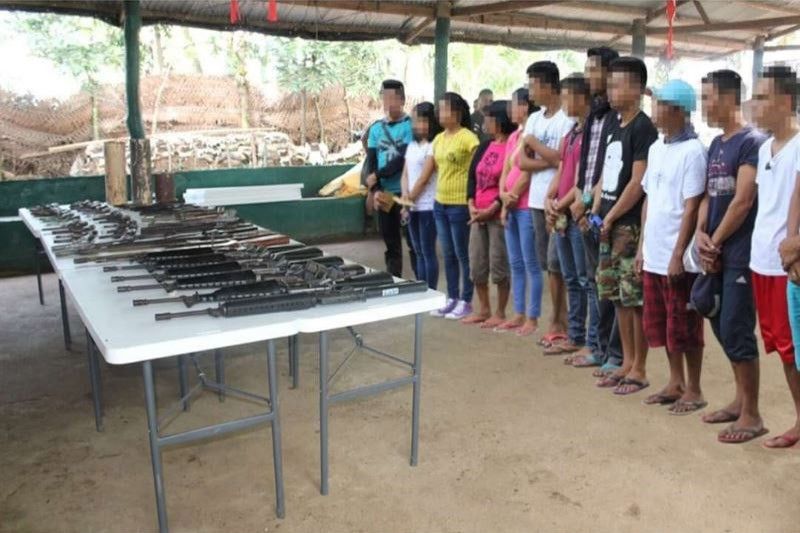'Honest mistake': Army apologizes for manipulated photo of alleged rebels

PANGASINAN, Philippines — The 9th Infantry Division of the Philippine Army on Saturday issued an apology admitting that the photo of alleged New People’s Army surrenderees that it released to the media was indeed manipulated.
“There were indeed 306 surrenderers in Masbate where negotiations begun sometime October 2019. The actual surrender was done [on] December 26, 2019,” Major Ricky Aguilar, spokesperson of the 9th Division, claimed in a Saturday statement.
"In our ardent desire to release timely information, we were not able to double check the pictures we attached in our press release yesterday December 26, 2019."
The army officer, however, did not explain why different images were combined and edited on Photoshop instead of simply concealing the faces of the alleged surrenderees to protect their identities.
The media, for example, would censor the faces of sources in sensitive stories for legal, ethical and/or safety reasons.
Honest mistake?
“Our line unit’s intention is not to mislead the public, but to protect the lives of the Former Rebels (FRs) who placed themselves at risk by surrendering to the government,” Aguilar said.
National Union of Journalists of the Philippines Chairperson Nonoy Espina, however, said that the intention was unmistakable.
“Can someone please explain how photo manipulation can ever be an ‘honest mistake’?” Espina posted on Twitter.
Can someone please explain how photo manipulation can ever be an "honest mistake"? ????
— nonoy espina (@EspinaNonoy) December 27, 2019
The journalist, along with other media and non-practitioners, earlier pointed out that the image was clearly fake due to inconsistencies like a rifle that was marked “18 Jun 2019” when the surrender supposedly took place this week.
BAD BURN. A very badly Photoshopped Army handout of "flying" surrenderees (look closely) makes it past the photo editors. Same pic used by a DDS page. They do replace it with a pic of the guns on the table, not noticing the one in the foreground has a sticker: "18 Jun 2019." pic.twitter.com/I9zraFxMK9
— nonoy espina (@EspinaNonoy) December 27, 2019
Other dubious elements observed by online users include the lack of shadows that should be cast by the human subjects in the photo, as well as one “surrenderer” having part of his feet erased.
Were the media used?
While the intent to deliberately mislead or fool is difficult to prove, the circumstances of how the manipulated pictures circulated is worth noting.
The photos, which were released to reporters via Viber, were ultimately circulated by at least two news outfits.
The report "Architects of Networked Disinformation,” which highlighted how false information circulated organically and systematically in the Philippines, said that news media are targeted due to their wide reach by people who produce and market false content to further amplify these.
“The goal here is to exploit mainstream new media’s vulnerability to reporting items that become popular in social media,” the report read.
Data & Society’s 2017 report “Media Manipulation and Disinformation Online” explained that the media are targeted and particularly vulnerable to such manipulation of information because of their overdependence on social media, analytics and metrics, sensationalism, novelty over newsworthiness, and clickbait.
Fake news?
Recent journalism discourse, however, favors new terms over the blanket phrase “fake news” which is “woefully inadequate to describe the complex phenomena of information pollution” and “appropriated by politicians around the world to describe news organisations whose coverage they find disagreeable.”
This is why the report “Information Disorder: Toward an Interdisciplinary Framework for Research and Policy Making” promotes the use of the terms “misinformation,” “disinformation” and “malinformation” to distinguish intention and the veracity of the content.
Misinformation and disinformation specifically deal with false information.
The first term is the unintentional sharing of false information, while the latter is knowingly sharing false information to cause harm.
Examples of misinformation listed by the Information Disorder report include elements like "false connection" and "misleading content."
However, elements like "false context," "imposter content," "manipulated content" and "fabricated content" are all classified as disinformation.
#fakenews: It’s complicated https://t.co/KUv7po77Bl "...this is about more than news, it’s about the entire information ecosystem" @cward1e pic.twitter.com/IX3syA6UPp
— First Draft (@firstdraftnews) May 2, 2017
It is unclear to what extent the separate elements (people, location, objects) in the manipulated photos released by the Philippine Army are real, but in any case, these would qualify as either fabricated or manipulated content.
Fabricated content is new content that is 100% false and designed to deceive and do harm, while manipulated content is genuine information or imagery is manipulated to deceive.
Based on the act itself, Espina’s argument stands that you can’t accidentally edit or manipulate a photo, thus deliberate intention is established.
Why though?
The Media Manipulation report said the common motivation for people who create and spread disinformation, propaganda, and/or fake news is “a combination of one or more of these categories—ideology, money, and/or status and attention.”
Amid the fake photo issue, online users have pointed out that the Philippine Army’s motivation for doing so is evidently propaganda against the New People’s Army amid ongoing interest for peace talks between the armed group and the government of the Philippines.
Digital journalism researcher Clair Wardle, co-author of the Information Disorder report, defines propaganda as “true or false information spread to persuade an audience, but often has a political connotation and is often connected to information produced by governments.”
The manipulated photo incident has since put the credibility of the Philippine Army into question, along with the government’s sincerity in the said peace talks.
It can be recalled that earlier this week, presidential spokesperson Salvador Panelo said that National Security Adviser Hermogenes Esperon's statement that President Rodrigo Duterte and other Cabinet officials are included in the NPA's hit list is "fake news," claiming that Esperson was given false information.
- Latest
- Trending

































